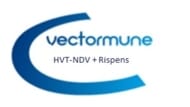
MAREK’S DISEASE – NEWCASTLE DISEASE VACCINE
VECTORMUNE® HVT NDV & RISPENS contains a genetically engineered Marek's Disease vaccine of serotype 3 (Turkey Herpes Virus or HVT) expressing a Newcastle disease key protective antigen, and a serotype 1 (Rispens) Marek’s Disease Virus. This vaccine is recommended for use in chickens as an aid in the prevention of Newcastle Disease and very virulent Marek’s Disease.
FOR ANIMAL USE ONLY
VECTORMUNE® HVT NDV & RISPENS
Reg No G4181 Act 36/1947
MAREK’S DISEASE – NEWCASTLE DISEASE VACCINE
Newcastle Disease (ND) is a controlled disease according to the Animal Diseases Act, Act 35/1984. Any occurrence or suspected occurrence of Newcastle Disease must be reported immediately to the local state veterinarian.
VECTORMUNE® HVT NDV & RISPENS contains a genetically engineered Marek's Disease vaccine of serotype 3 (Turkey Herpes Virus or HVT) expressing a Newcastle disease key protective antigen, and a serotype 1 (Rispens) Marek’s Disease Virus. This vaccine is recommended for use in chickens as an aid in the prevention of Newcastle Disease and very virulent Marek’s Disease.
STORAGE
Ampoules containing live frozen vaccine: Store in liquid nitrogen
Diluent : Store at room temperature between 20 – 25 °C
COMPOSITION
Marek’s Disease, HVT– Newcastle Disease (rHVT/NDV) ≥2 474 PFU through expiration
Marek’s Disease, Rispens CVI -988 strain ³1 206 PFU through expiration
Preservatives: Gentamicin and Amphotericin B
COMPOSITION
Marek’s Disease, HVT– Newcastle Disease (rHVT/NDV) ≥2 474 PFU through expiration
Marek’s Disease, Rispens CVI -988 strain >1 206 PFU through expiration
Preservatives: Gentamicin and Amphotericin B
WARNINGS
PRECAUTIONS
DOSAGE AND DIRECTIONS FOR USE: USE ONLY AS DIRECTED. Carefully read the directions before use. The instructions must be completely followed. VECTORMUNE® HVT NDV & RISPENS must be administered by in ovo vaccination in 18 - 19 day old embryonated eggs or by subcutaneous vaccination in day old chicks. Vaccine preparation: Be familiar with all safety and precautionary measures for handling liquid nitrogen to prevent personal injury. Wear gloves, face protection and protective clothing. Check the liquid nitrogen container to confirm a sufficient amount of liquid nitrogen is present to keep the vaccine frozen. If thawed, do not use the vaccine. The containers (Dewar) must be checked regularly for liquid nitrogen level and must be refilled as needed. After calculating the number of doses of vaccine and diluent required, quickly remove the exact amount of ampoules needed. A maximum of 4 ampoules should be thawed at one time. After inspecting the diluents and completing all preparations, the vaccine should be quickly removed from the Dewar and placed into a water bath of 26,5 °C to thaw. This step can be repeated until the appropriate dosage has been reached. Gentle agitation during the thawing process promotes rapid, uniform thawing and evenly distributes the vaccine in the ampoule. Immediately after thawing, mix vaccine with diluent at room temperature. Gently draw the vaccine from the ampoule with an 18-gauge, 1,5 inch needle and slowly mix with the diluent. (See diluent vaccine ratio below). Immediately use the vaccine and agitate occasionally to ensure uniform suspension of cells. Administration of vaccine:
Sterilize the automatic syringe, needles and other accessories by auto claving or boiling prior to vaccination. Use a short 20 gauge needle for vaccination. Mix 200 mℓ of diluent for each 1 000 doses of vaccine. Subcutaneously inject 0,2 mℓ of diluted vaccine into the back of the neck of each chick. The preferred site is under the skin on the back of the neck midway between the head and the body and in a direction away from the head. Do not inject near the head. Do not inject into the muscle tissue or the neck vertebrae.
Sanitize the egg injection system before and after use following procedures described in operator’s manual. Read the egg injection system operator’s manual before initiating vaccination. Failure to follow instructions may result in personal injury, excessive embryonic mortality and low hatchability. Mix 100 mℓ of diluent for each 1 000 doses of vaccine to administer 0,1 mℓ per chicken embryo or mix 50 mℓ for each 1 000 doses of vaccine to administer 0,05 mℓ per chicken embryo. PRESENTATION 2 mℓ fire sealed glass ampoules containing 1 000, 2 000 or 4 000 doses stored in liquid nitrogen. REGISTRATION HOLDER Ceva Animal Health (Pty) Ltd Reg No 1973016009/07 P O Box 7707 Halfway House, 1685 RSA |
Tel +27 11 312 4088
MANUFACTURER Ceva Biomune 8906 Rosehill Road Lenexa Kansas 66215 USA U.S. Vet Lic. No. 368 |

 Corporate Website
Corporate Website
 Africa
Africa
 Argentina
Argentina
 Asia
Asia
 Australia
Australia
 Belgium
Belgium
 Brazil
Brazil
 Bulgaria
Bulgaria
 Canada (EN)
Canada (EN)
 Chile
Chile
 China
China
 Colombia
Colombia
 Denmark
Denmark
 Egypt
Egypt
 France
France
 Germany
Germany
 Greece
Greece
 Hungary
Hungary
 Indonesia
Indonesia
 Italia
Italia
 India
India
 Japan
Japan
 Korea
Korea
 Malaysia
Malaysia
 Mexico
Mexico
 Middle East
Middle East
 Netherlands
Netherlands
 Peru
Peru
 Philippines
Philippines
 Poland
Poland
 Portugal
Portugal
 Romania
Romania
 Russia
Russia
 South Africa
South Africa
 Spain
Spain
 Sweden
Sweden
 Thailand
Thailand
 Tunisia
Tunisia
 Turkey
Turkey
 Ukraine
Ukraine
 United Kingdom
United Kingdom
 USA
USA
 Vietnam
Vietnam
